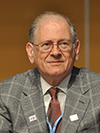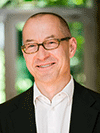 |
Dr. Robert E. Kahn
CEO
Corporation for National Research Initiatives, Reston (USA)
Curriculum Vitae
Robert E. Kahn is Chairman, CEO & President of the Corporation for National Research Initiatives (CNRI), a non-profit organization he founded in 1986 to focus on information infrastructure research & development in the public interest. Dr. Kahn received a B.E.E. from the City College of New York in 1960, and M.A. and Ph.D. degrees from Princeton University in 1962 and 1964 respectively. He worked on the Technical Staff at Bell Laboratories and then became an Assistant Professor of Electrical Engineering at MIT. In 1966, he took a leave of absence from MIT to join Bolt Beranek & Newman (BBN), where he was responsible for the system design of ARPANET, the pioneering packet switched computer network. In 1972, he moved to DARPA and subsequently became Director of DARPA's Information Processing Techniques Office (IPTO), where he initiated the United States Government's Strategic Computing Program, the largest computer research and development program ever undertaken by the federal government to that time. Dr. Kahn conceived the idea of open-architecture networking. He is a co-inventor of the TCP/IP protocols and was responsible for originating DARPA's Internet Program. More recently, he has been involved in development and deployment of the Digital Object Architecture, an open architecture for managing information in the Internet. He is Chairman of the DONA Foundation, a Swiss non-profit organization established in 2014. Dr. Kahn is the recipient of numerous honorary degrees and awards.
Abstract: Challenges and Opportunities for Digital Preservation
An important challenge for digital preservation is getting agreement on an architecture that can persist in the face of changing technology, thus allowing independent technology choices to be made over time. Seven critical aspects of such an architecture are discussed in this talk, namely 1) the structure of information represented in digital form and the means of identifying it, 2) assuring that the elements within the structure can be interpreted as originally intended over time, 3) providing for interoperability with integrated security, 4) specifying levels of abstraction for metadata, its connection with the associated “data”, and enabling it to support evolution of searching techniques, 5) simplifying access to digital information, especially information preserved long ago, 6) determining relevant performance metrics for implementations of the architecture and 7) evaluating the performance of such implementations. Another important challenge is to develop and evolve the social structures required for effective management and evolution of the architecture. The Digital Object Architecture represents an excellent opportunity for the preservation community to embrace and will be briefly discussed along with possible social structures to enable the architecture to persist and evolve.
|
 |
Sabine Himmelsbach
Director
Haus der elektronischen Künste Basel, Basel (CH)
Curriculum Vitae
Sabine Himmelsbach is director of HeK (House of Electronic Arts Basel) since 2012.
She has worked for galleries in Munich and Vienna; at the Steirischer Herbst Festival in Graz, Austria; as exhibition director and curator at the ZKM | Center for Art and Media in Karlsruhe and she was the artistic director of the Edith-Russ-House for Media Art in Oldenburg, Germany, from 2005 to 2011. She has curated numerous exhibitions, most recently ‹Perspectives on Imaginary Futures› (2014), ‹Ryoji Ikeda› und ‹Poetics and Politics of Data› (2015). As a writer and lecturer she is dedicated to topics related to media art and digital culture.
Abstract: Net-based and Networked – Challenges for the Conservation of Digital Art
Digital art, in its countless manifestations, has become an integral part of contemporary art production. Its cultural relevance is unquestioned, but its conservation does present new challenges to museums and collections alike. After all, we are not talking about static objects that can be “stabilized” in the classical sense; rather, digital art is akin to performance because new conditions can arise in each process or each performance. What can be done if the technology is already out of date the moment you switch on the computer? How do we deal with works of art that are dependent on proprietary software that’s no longer being updated by its manufacturers, or whose manufacturer no longer exists? How can net-based projects be preserved for the future? In an era of rapid technological change and short-lived technologies, the question of how best to conserve our digital heritage is becoming increasingly urgent. Conservation of digital content and digital born art faces many problems – fragility, digital longevity and technological obsolescence are some of the concerns that have had to be dealt with for many years. Net-based and networked art are built and distributed within a complex system that often includes social media or other restricted platforms. Digital culture consists of "practices, not objects” - art, technology, media and social relations are merged into a networked process. We constantly have to adapt our tools and practices to fit the performative and processual practices of artworks we seek to preserve, works that are in a constant state of flux. To preserve web-based works of art, stakeholders of cultural heritage also have to deal with the inter-relatedness and rhizomatical structure of artworks that reference dynamic and real-time data sources and must develop new methods for the documentation of digital content.
With examples of works from the collection of HeK (House of Electronic Arts Basel) as a
unique institution with a pioneering role in Switzerland, the presentation gives insight into
software-based artistic practice and the complex tasks of preservation of digital art that can be described as a networked process. HeK has focused on net-based works and preserves therefore an artistic practice that represents a particular challenge for musealization. The presentation will focus on some of the challenges and opportunities in the conservation and contextualisation of these media art practices for museums, emphasizing the collaborative approach and cooperation beyond institutional borders. In the process, we will explore the issues related to the “performative phase in conservation" and look at why it is important to initiate a "network of care," composed of research institutions, museums, artists and amateurs alike, active in the fields of open-source culture – a valuable contribution to the preservation of digital culture.
|
 |
Dr. David Bosshart
CEO
Gottlieb Duttweiler Institut für Wirtschaft und Gesellschaft, Rüschlikon/Zürich (CH)
Curriculum Vitae
Dr. David Bosshart, CEO of the GDI Gottlieb Duttweiler Institute for economic and social studies, Rüschlikon/Zurich. The GDI is an independent European think tank, founded by European retail pioneer Gottlieb Duttweiler (1888-1962). The institute specializes in trend research, retail, economic and social issues. The Gottlieb Duttweiler Prize is Switzerland’s most prestigious award for outstanding personalities, dedicated only every couple of years (1989 Václav Havel, 2004 Joschka Fischer, 2008 Kofi Annan, 2011 Jimmy Wales, 2015 Sir Tim Berners-Lee).
Following high school and a business education, Bosshart capped his studies with a Ph.d. from the University of Zurich in philosophy and political theory. He has been involved in communications and marketing consulting, in retailing and in scientific research. 1991–1996 head of department of consumer research and social change at the GDI. 1997–1999 head of strategic development and director of the cultural and social section of the Federation of Migros Cooperatives (the famous culture percentage). Bosshart has been in his current position since 1999.
Abstract: Digital memories, digital futures – the interplay between humans and technology
We’re moving form an industrial to a digital age. Acceleration, mobility, connectivity, real time information for free are the new normal. Everything seems to happen now. We live in a world of presentism: Search and social are now the main sources of information, breaking news and live tickers surround us. Boundaries between the public and the private are collapsing.
People everywhere have higher expectations. Where does this lead? Each new medium creates new communication styles and designs information differently. What is the future importance of images, symbols, voice vs. written language? The software invention turns out to be as important as the invention of money or the written language. What new needs are emerging?
How will the human-machine relationship evolve with ever better AI? Is AI am the new I am? When everybody becomes a creator and a maker, and generated data volume increases exponentially, what is important and what is unimportant? Who is in control? Who is going to make decisions?
Will we think of the past and the future the same way like today? Hardly. Our world is already a living museum – ever more data and things are either put on shelves or in the cloud. Will an idealized past become more important? Probably. Will the future create positive connotations? We hope so.
|
![]() Programme overview | R. E. Kahn | S. Himmelsbach | D. Bosshart
Programme overview | R. E. Kahn | S. Himmelsbach | D. Bosshart![]() Programme overview | R. E. Kahn | S. Himmelsbach | D. Bosshart
Programme overview | R. E. Kahn | S. Himmelsbach | D. Bosshart